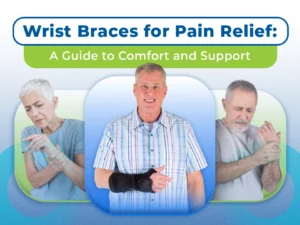In this article, we discuss the potential causes of shoulder pain, such as shoulder arthritis, as well as the shoulder braces that will provide pain relief. The shoulder joint is the most mobile joint in the body and it’s made up of three main bones: the humerus, scapular, and clavicle. They work together with the muscles and ligaments to keep the shoulder stable and mobile. However, the high level of mobility at the joint makes the shoulder highly susceptible to injury and subluxation.
There are many types of shoulder injuries you can experience. Pain could be stemming from a dislocation, a sprain, a strain, separation, tendinitis, a torn rotator cuff, or something else. If you’ve recently had a shoulder injury, then you’re searching for the right treatment for your pain. It can be stressful not knowing where to start.
Fortunately, when you get the right shoulder brace for your injury, you can heal faster while still being able to carry out your everyday activities. How do you choose the right shoulder brace, though?
In this article, we’ll review everything you need to know about finding the shoulder brace that’s right for you. Finally, you can start healing and moving on from your injury. Read on to learn more.
Which Shoulder Brace Is Right for You?
To find the right shoulder brace for you, you’ll need to understand what brace types are available and what their features are. The first type is one for injury or dislocation. This shoulder brace usually includes a sling.
There are also shoulder stabilizing braces. These braces are an all-in-one piece, offering support from chest to shoulder. These include a compression sleeve and a brace that wraps around the chest.
There are also posture shoulder braces, which wrap around your waist and hold back both of your shoulders.
Who A Shoulder Brace Is Meant For
Shoulder braces are usually for when an injury affects your shoulder. You can recover faster by combining physical therapy with the use of your brace. Some braces even immobilize your shoulder and arm completely to speed up healing.
Others provide compression and are ideal for athletes. These braces should give the wearer support and protection while enabling the athlete with a mild injury to continue performing.
There are specific injuries that are best suited for this product, which we’ll review below.
Shoulder Dislocation
Because the shoulder joint is the body’s most mobile joint, it’s the one that’s most likely to dislocate. This injury usually occurs from trauma, like being tackled during a football game or suffering a car accident.
By wearing a shoulder brace, the injury can heal while your shoulder is immobilized. If you need surgery because of the dislocation, the shoulder brace will assist in the joint’s recovery.
Impingement Syndrome
Doing repetitive upwards movements with your arms, for example, at a job where you’re often lifting heavy objects, could end up producing shoulder impingement syndrome. When this happens, tiny bone spurs start to develop. These spurs cause your rotator cuff tendons to become trapped above your main shoulder point. With a shoulder brace, you can limit movement and decrease pain so that the area will heal.
ACJ Injuries
ACJ injuries, short for acromioclavicular joint injuries, occur on the very top part of your shoulder. Athletes commonly experience this injury, for example, when they fall on their shoulders repeatedly. You can also dislocate this part of the shoulder.
Wearing a shoulder brace will minimize the inflammation and swelling your shoulder experiences. Additionally, if you’ve had to get surgery, the brace will help stabilize your dislocated ACJ afterward.
Labral Tears
The labrum is a cushion that surrounds your shoulder joint socket. You get a labral tear by falling or experiencing a direct blow to it, though this can also happen while pulling or throwing.
A shoulder brace helps you manage blood flow to the labrum area and provides support, decreasing pain and repairing the labral tear.
Rotator Cuff Tears
Your rotator cuff is a vital tendon group that stabilizes your shoulder and provides mobility. When you damage it, this leads to weakness and pain. Tears from this injury can benefit greatly from the support and immobilization a shoulder brace offers.
Without it, the tear could become bigger and, therefore, more difficult to repair. Once it has healed, the brace will also strengthen the area, helping to prevent re-injury.
Shoulder Arthritis
Finally, anyone suffering from shoulder arthritis should use a shoulder brace. The joint is painful and stiff because it loses its original lubrication. A brace will strengthen your shoulder joint and allow you to experience less arthritis-related pain.
How To Use A Shoulder Brace
To use a shoulder brace, you first have to put it over your shoulder. The middle bar should parallel your arm’s and elbow joint’s top. The strap will go around your back, after which you’ll secure it with the buckle.
As for the padded sleeve, this will go under your axilla or opposite arm, for comfort. You also may need to readjust the straps so they will fit correctly. It also may help to have a medical professional show you how to put it on so that you can do it correctly at home.
How To Maintain The Brace
In most cases, you should wear your shoulder brace at all times. Some are not designed for use while in the shower or for exercise, so check the instructions to see if this applies to you.
If your sleeve doesn’t have any metal components, you can wash it every few days. If it’s a larger brace with a metal structure, you should use a damp washcloth to wipe it down at the end of each day.
Some braces, such as ones with hinges, have to be lubricated occasionally so they keep working. If you notice that any parts have come loose or are squeaking, you should replace them. You might have to get a new one if the entire brace is connected without any removable parts.
The more you maintain your shoulder brace, the longer it will last.
Pros And Cons Of Shoulder Braces
The pros of using a shoulder brace are that it can promote healing and keep your injury from getting worse over time. Combined with physical therapy or exercises prescribed by your doctor, you’ll start to heal faster than you would without it.
There are also some cons to using a shoulder brace. These include that it’s aesthetically unappealing, it is not a replacement for physiotherapy or another type of rehabilitation program, and that you can become too reliant on it. If you wear it for too long, you could even end up experiencing muscle atrophy or putting too much pressure on other muscles.
Bottom Line
If you’re suffering from shoulder pain, you must talk to a doctor before your pain worsens. Going to a doctor before trying one of these shoulder braces is extremely important. Fast and adequate treatment can help you avoid pain in the future.







